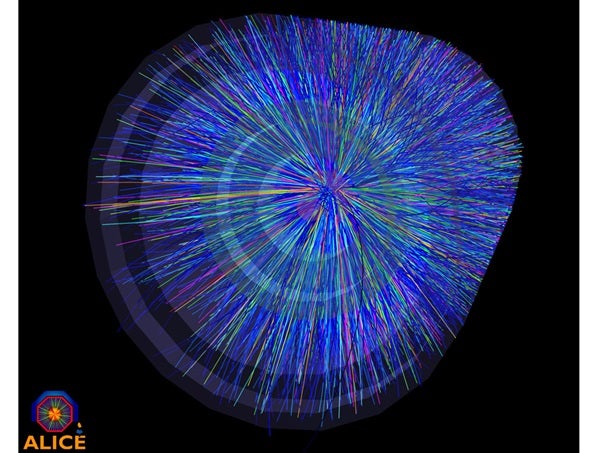“We are thrilled with the achievement,” said David Evans from the University of Birmingham, United Kingdom. “The collisions generated mini Big Bangs and the highest temperatures and densities ever achieved in an experiment.”
“This process took place in a safe, controlled environment generating incredibly hot and dense subatomic fireballs with temperatures of over 10 trillion degrees, a million times hotter than the center of the Sun,” said Evans. “At these temperatures, even protons and neutrons, which make up the nuclei of atoms, melt, resulting in a hot dense soup of quarks and gluons known as a Quark-Gluon Plasma. By studying this plasma, physicists hope to learn more about the Strong Force, one of the four fundamental forces of nature. The Strong Force not only binds the nuclei of atoms together, but it is responsible for 98 percent of their mass. I now look forward to studying a tiny piece of what the universe was made of just a millionth of a second after the Big Bang.”
“I am so excited that the ALICE experiment is finally going to be able to glimpse lead ion collisions from the LHC,” said Birmingham University student Zoe Matthews. “The environment the collisions will create is mind-blowing, and observing them will offer up insights about the earliest moments in our universe’s life. I feel so lucky to be a small part of this exciting piece of history.”
The 10,000-ton ALICE experiment has been specifically designed to study the extreme conditions produced in these lead collisions. While the conditions created in the LHC detector will be a world record for man-made experiments and represent a great achievement for science and engineering, they pose no threat. More energetic particle reactions occur regularly throughout the universe, including in the upper atmosphere of Earth.
ALICE is one of the four main experiments at the LHC designed to study the physics from ultra-high energy proton-proton and lead-lead interactions.
“We are thrilled with the achievement,” said David Evans from the University of Birmingham, United Kingdom. “The collisions generated mini Big Bangs and the highest temperatures and densities ever achieved in an experiment.”
“This process took place in a safe, controlled environment generating incredibly hot and dense subatomic fireballs with temperatures of over 10 trillion degrees, a million times hotter than the center of the Sun,” said Evans. “At these temperatures, even protons and neutrons, which make up the nuclei of atoms, melt, resulting in a hot dense soup of quarks and gluons known as a Quark-Gluon Plasma. By studying this plasma, physicists hope to learn more about the Strong Force, one of the four fundamental forces of nature. The Strong Force not only binds the nuclei of atoms together, but it is responsible for 98 percent of their mass. I now look forward to studying a tiny piece of what the universe was made of just a millionth of a second after the Big Bang.”
“I am so excited that the ALICE experiment is finally going to be able to glimpse lead ion collisions from the LHC,” said Birmingham University student Zoe Matthews. “The environment the collisions will create is mind-blowing, and observing them will offer up insights about the earliest moments in our universe’s life. I feel so lucky to be a small part of this exciting piece of history.”
The 10,000-ton ALICE experiment has been specifically designed to study the extreme conditions produced in these lead collisions. While the conditions created in the LHC detector will be a world record for man-made experiments and represent a great achievement for science and engineering, they pose no threat. More energetic particle reactions occur regularly throughout the universe, including in the upper atmosphere of Earth.
ALICE is one of the four main experiments at the LHC designed to study the physics from ultra-high energy proton-proton and lead-lead interactions.










